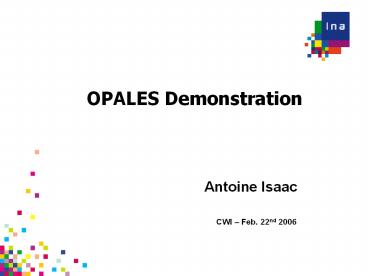OPALES Demonstration - PowerPoint PPT Presentation
Title:
OPALES Demonstration
Description:
Tools to share knowledge in educational/scientific ... Conceptual Graphs formalism. 2006-02-22. Antoine Isaac CWI Talk. 8. Ontology-based annotation ... – PowerPoint PPT presentation
Number of Views:61
Avg rating:3.0/5.0
Title: OPALES Demonstration
1
OPALES Demonstration
Antoine Isaac
- CWI Feb. 22nd 2006
2
OPALES
- French Project (RIAM, 2001-2003)
- Partners
- Developers
- INA (Coordinator)
- LIRMM (IHM, GC)
- CS
- Users
- CNRS (video library)
- MSH (humanities, communication)
- CNDP (educational material)
3
Tools to share knowledge in educational/scientif
ic communities
- Goals
- Sharing and exploiting AV resources
- Fitting the needs of various specific user
communities - Approach
- Accessing document via annotations
- Similar to classical indexing approach
- Interpretation of AV content used for
exploitation - Ensuring the relevance of annotation for
communities and applications - Using points of view
4
Points of view
- Exploitation of annotation/indexes needs semantic
continuity - Shared interpretation/coherent manipulation for
indexer/searcher/system - OPALES points of view
- Mirror specific application/community needs
- Embody annotation policies
- Gather users who choose them for creating or
filtering annotations - Thorough experiments with 2 points of view
- Ethnology-oriented analysis of videos regarding
childhood - Educational exploitation of geographic
information films
5
Points of view and annotation/search policies
- Free-text annotation and search
- Natural interpretation of AV content
- Form-based annotation and search
- Predefined structure
- Basic control (value lists)
6
OPALES Forms
7
Points of view and annotation/search policies
- Free-text annotation and search
- Natural interpretation of AV content
- Form-based annotation and search
- Predefined structure
- Basic control (value lists)
- Ontology-based annotation and search
8
Ontology-based annotation and search
- Explicit and flexible structuring of index
elements - Added value of relations for rich indexing
- Conceptual Graphs formalism
9
Ontology-based annotation
10
Ontology-based annotation and search
- Explicit and flexible structuring of index
elements - Control ensured by formal specifications
- Inference
- Taking into account (viewpoint-specific) implicit
knowledge to link queries to indexes - Cogitant CG inference engine
11
Problems of ontology-based approach
- Complex indexing process
- Difficult to get accustomed to
- Especially for people not used to KR
- Coupling design of complex ontological knowledge
with use - Legitimate conceptualisation w.r.t. application
and practice - Specification of formal inference knowledge
12
DOE ontology editor
- Semi-informal semantics Bachimont
- Differential principles inter-defining notions by
similarities and differences - Meaning naturally linked to an application domain
- Compatible with extraction of ontology elements
from textual resources - Véronique Malaisé
- Compatible with further formalization
13
DOE
- http//opales.ina.fr/public Bachimont, Isaac,
Troncy - (now http//homepages.cwi.nl/troncy/DOE/ !)
14
Indexing patterns
- Determine relational template recurrent in aimed
information practices - Dependent on point of view
- Propose those structures to the indexer as a
starting point for description
15
Indexing patterns example (1)
English
16
(No Transcript)
17
Indexing patterns example (3)
English
18
Patterns and reasoning
- Comparison index/query
- Pattern as an implicit pivotal structure,
compensating for description/query variations - Inferring facts from pattern structure
- Inferring pattern-fitting facts from different
structure
19
Conclusion
- Points of view as materialization of indexing and
exploitation strategies - Knowledge-based tools
- Expressivity, control and inference
- Experimentation (two qualitative evaluations with
domain users) shows that there are obstacles - No familiarity of targeted users with formal
techniques - Difficulty for the knowledge workers to design
proper ontological resources for each point of
view
20
Conclusion
- Experimentation shows that approach is made
feasible by - Ontologies linked in quite a natural way to
meanings and practices targeted by points of
views - Differential principles help ontology designers
work and final users understanding - Formalizing users needs by Indexing Patterns
- Both for description and query
- Also legitimates ontology designers work
- Turning to relational reasoning for
compensating variations - Remark complexity goes now for KR engine
- Techniques to ensuring semantic continuity in
ontology-based indexing and search
21
THANK YOU !
22
Childcare use pattern
Back
23
Specialised index
Back































